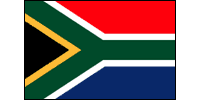| Country (long form) |
Republic of South Africa |
| Capital |
Pretoria;
note - Cape Town is the legislative center and Bloemfontein the judicial center |
| Total Area |
471,010.66 sq mi
1,219,912.00 sq km
(slightly less than twice the size of Texas) |
| Population |
43,586,097 (July 2001 est.)
note: South Africa took a census October 1996 which showed a population of 40,583,611 (after an official adjustment for a 6.8% underenumeration based on a postenumeration survey); estimates for this country explicitly take into account the effects of excess mortality due to AIDS; this can result in lower life expectancy, higher infant mortality and death rates, lower population and growth rates, and changes in the distribution of population by age and sex than would otherwise be expected |
| Estimated Population in 2050 |
32,538,704 |
| Languages |
11 official languages, including Afrikaans, English, Ndebele, Pedi, Sotho, Swazi, Tsonga, Tswana, Venda, Xhosa, Zulu |
| Literacy |
81.8% total, 81.9% male, 81.7% female (1995 est.) |
| Religions |
Christian 68% (includes most whites and Coloreds, about 60% of blacks and about 40% of Indians), Muslim 2%,
Hindu 1.5% (60% of Indians), indigenous beliefs and animist 28.5% |
| Life Expectancy |
47.64 male, 48.56 female (2001 est.) |
| Government Type |
republic |
| Currency |
1 rand (R) = 100 cents |
| GDP (per capita) |
$8,500 (2000 est.) |
| Industry |
mining (world's largest producer of platinum, gold, chromium), automobile assembly, metalworking, machinery, textile, iron and steel, chemicals, fertilizer, foodstuffs |
| Agriculture |
corn, wheat, sugarcane, fruits, vegetables; beef, poultry, mutton, wool, dairy products |
| Arable Land |
10% |
| Natural Resources |
gold, chromium, antimony, coal, iron ore, manganese, nickel, phosphates, tin, uranium, gem diamonds, platinum, copper, vanadium, salt, natural gas |
|


|